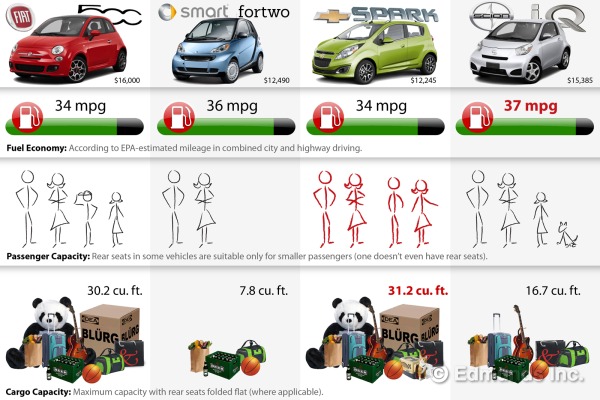
One size smaller than subcompacts, microcars are the tiniest cars on the market. The segment has long been big in Europe, but it's only recently begun to gain a foothold in the U.S. The models in this category have excellent fuel economy and low pricing in their favor, and their diminutive dimensions give them easy maneuverability in the city. If you're on a tight budget and have modest needs regarding passenger capacity and cargo room, a microcar could very well be your ideal urban runabout.
Chevrolet Spark
Value is one of the Chevy Spark's key traits, given that it offers a robust complement of tech features and the lowest starting price in the segment. In its top trim level, it's available with goodies like Bluetooth phone and streaming audio, satellite radio and Internet radio options when paired with smartphones. This tiny Chevy is also the most ambitious pick in the microcar class when it comes to versatility. Unlike its rivals, the Spark has four doors, allowing rear passengers to easily enter and exit without squeezing past those seated in front. And with 35.2 inches, it's far and away the class leader in rear legroom.
The Spark travels with well-planted composure and feels substantial on the road — an unusual trait in this segment. Keep in mind, though, that with just 85 horsepower on tap, this little Chevy has one of the weakest engines in its class. Power is certainly adequate enough, but if bracing acceleration is high on your list of priorities, you'll need to look elsewhere.
Best for: The most price-sensitive shoppers; those who want a microcar with subcompact utility
Fiat 500
With its Euro-chic sheet metal, retro-cool interior and palette of designer colors, the Fiat 500 makes a play for car shoppers with an eye for style. Thanks to its wide array of customization options, it's easy to outfit the 500 in a way that's personal and unique. While it seats two graciously, you're in for a tight fit if you try to accommodate anyone in its rear seat.
Good for 101 hp, the Fiat 500 has the most power in the segment, while the Abarth variant is equipped with a turbocharged 1.4-liter good for 160 hp (of course, it also comes with a price tag that's about $6,500 steeper than that of the base 500). Handling is sharp and enjoyable on Sport and Abarth models, making this a good choice for those who don't mind paying a little extra for a sportier driving experience (the 500's starting price is the costliest in its class). With fuel economy of 40 mpg, the 500 gets the best highway mileage in the segment.
Best for: Microcar shoppers who value sporty handling; buyers who like a car with lots of visual flair; those who do lots of highway driving
Scion iQ
Like the 500, the iQ aims to woo shoppers with a yen for distinctive-looking transportation that makes a personal statement. Its lines are cute and crisp, with an aesthetic that wouldn't seem out of place on Tokyo's modern streets. A wide array of tech amenities is available, and — like the Fiat — the iQ is readily customized. With just 28.6 inches of rear legroom, its backseat is cramped (the car is described as a 3+1 rather than a four-seater), and cargo capacity is also pretty modest — just 3.5 cubic feet with all seats in place.
Its engine offers 94 hp, making the Scion a runner-up in the segment's horsepower race. Measuring just 120.1 inches in length, the iQ is the second smallest choice in the segment, and its ultra-petite footprint makes for breezy maneuverability in the city. Despite its bantam proportions, however, acceleration is less than brisk.
Best for: Shoppers who love its anime-like aesthetic; those with minimal cargo- and passenger-capacity requirements
Smart Fortwo
The Smart Fortwo holds the distinction of being the model that got things started domestically in the microcar segment. However, while it may have been the first, it's a long way from being the best in this growing category. This little hatchback has size — or lack of it — in its favor. With a length of just 106.1 inches, it's the smallest model in the segment, and this allows it to easily find its way into even the tightest of parking spaces.
However, the Fortwo is significantly hampered by its transmission, an automated manual that enhances mpg at the price of some clumsiness in the way it shifts gears, adding an element of unpredictability to even the most basic maneuvers. With just 70 hp, this Smart has the weakest engine in the segment, but its light weight ensures that drivers don't pay a harsh penalty for this when it comes to acceleration. While the car's miniature proportions are an asset in the city, they're a hindrance on the highway, making the little Smart susceptible to crosswinds and adding an unsettling element of insecurity to freeway travel.
Best for: Shoppers seeking the tiniest, easiest-to-park model in the segment
Charts, Specifications, Information
For further information:
Compare Microcar Specs Side-by-Side
2013 Chevrolet Spark Model Review
2013 Fiat 500
2013 Scion iQ Model Review
2013 Smart Fortwo